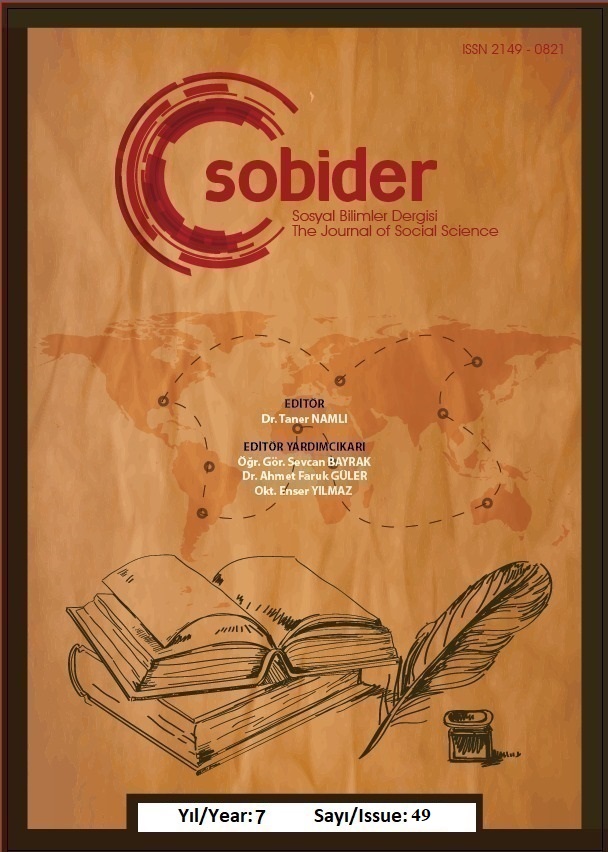Author :
Abstract
Bu çalışmada T.C. Ulaştırma ve Alt Yapı Bakanlığı tarafından yürütülen Yüksek Hızlı Tren (YHT) projesi üzerinde bulunan Pendik Höyük kurtarma kazısından elde edilen seramiklerin karakterizasyon çalışmaları ele alınmıştır. Bahsi geçen höyük, ekolojik faktörlerin etkisiyle Neolitik Dönem’den Bizans Dönemi’ne kadar yerleşim görmemiştir. Bu nedenle yapılan bu çalışmada, hem ekolojik duruma hem de kil yapısına bağlı olarak seramik üretiminin değişimi üzerinde arkeolojik ve spektroskopik açıdan iki aşama halinde multidisipliner çalışma gerçekleştirilmiştir. İlk etapta deneysel çalışmalar ele alınmış ve basit spot testleri uygulanmıştır. Bu kapsamda klorür, nitrat ve sülfat analizleri ile iletkenlik ölçümü, protein ve yağ analizleri yapılmıştır. Daha sonra yapıdan alınan örneklerin karakterize edilmesi amacıyla arkeometride sıklıkla kullanılan petrografi analizi uygulanmıştır. Ardından örneklerin kimyasal, mineralojik ve yapısal özelliklerinin belirlenmesi amacıyla yukarıda belirtilmiş deneylere ek olarak enstrümantel analiz teknikleri de kullanılmıştır. Örneklerin kil niteliklerinin, bölgesel ve noktasal olarak kimyasal bileşim oranları SEM-EDS analizi ile mineralojik içeriği XRD analiz ile belirlenmiştir. Bu bağlamda, bu çalışmada yer alan seramiklerin yapısı, üretim tekniği gibi niceliksel ve niteliksel tüm özellikleri arkeometrik ve analiz sonuçlarının katkısıyla açığa çıkarılarak mutlak bilgilere ulaşılmaya çalışılmıştır.
Keywords
Abstract
In this study, characterization studies of ceramics obtained from Pendik Höyük rescue excavation on High Speed Train (YHT) project carried out by the Rebuclic of Turkey Ministry of Transport and Infrastructure. Two distinct stage, Late Neolithic and Byzantine, were observed during the excavations on the mound. The mentioned mound was not inhabited from the Neolithic Period to the Byzantine Period due to ecological factors. For this reason, in this study, a multidisciplinary study was carried out in two stages in archaeological and spectroscopic terms on the change of ceramic production depending on both the ecological situation and the clay structure. At the first stage, experimental studies were discussed and simple spot tests were applied. In this context, chloride, nitrate and sulphate analyzes, conductivity measurement, protein and fat analyzes were performed. Then, petrography analysis, which is frequently used in archeometry, was applied to characterize the samples taken from the structure. Subsequently, instrumental analysis techniques were used in addition to the above-mentioned experiments in order to determine the chemical, mineralogical and structural properties of the samples. The regional and point chemical composition ratios of the clay properties of the samples were determined by SEM-EDS analysis and the mineralogical content by XRD analysis. In this context, all qualitative and quantitative features of the these ceramics, such as the structure and production technique, were revealed with the contribution of archaeometric and analysis results and absolute information was tried to be reached in this study.
Keywords
- Bittel K. (1960). Fikirtepe Kazısı. TTK V. Kongre Raporu. 29-36.
- Bittel K. (1971). Bemerkungen über die prähistorische Ansiedlung auf dem Fikirtepe bei Kadıköy. Istanbuler 6 Mitteilungen, 19 (20). 1-19.
- Borelli, E. (1999). Conservation of Architectural Heritage, Historic Structures and Materials, Salts, Arc Laboratory Handbooks, ICCROM, S.p.A., Rome. vol. 3.
- Efe T. (2007). I. Eskişehir Bölgesi Tarih Öncesi Dönem Araştırmaları ve Önasya Arkeolojisi İçindeki Yeri. 1-46.
- Ersen, A., Güleç, A. (2009). Basit ve İleri Analiz Yöntemleri ile Tarihi Harçların Analizi Konservasyon Çalışmaları. KUDEB, İstanbul, 3. 65-73. Evstratiou N. (1985). Agios Petros. A Neolithic site in the Northern Sporates. BAR International Series 241.
- French, D. (1965). Early pottery sites from western Anatolia. Bulletin of the Institute of Archaeology, 5. 15-24.
- Gatsov I. (2003). The Latest Results from the technological and typological analysis of chipped Stone assemblages from Ilıpınar. Pendik, Fikirtepe and Menteşe, Documenta Prehistorica 30. 153-157.
- Gölbaş, Alper (2010). Neolitik Anadolu Toplumlarının Geçim Ekonomisinde Su Ürünleri. 18 Mart Üniversitesi Sosyal Bilimler Enstitüsü. (Yayımlanmamış Yüksek Lisans Tezi).
- Güleç, A. (1992). Bazı Tarihi Anıt Harç ve Sıvalarının İncelenmesi. (Yayınlanmamış doktora tezi). İ.T.Ü. Fen Bilimleri Enstitüsü.
- Güleç, A. ve Ersen, A. (1998). Characterization of ancient mortars: Evaluation of simple sophisticated methods. Journal of Architectural Conservation. 1.
- Harmankaya S. (1983). Pendik Kazısı 1981. Kazı Sonuçları Toplantısı IV. 25-30.
- Kansu, Ş. A. (1963). Marmara Bölgesi ve Trakya’da Prehistorik İskân Tarihi Bakımından Araştırmalar, 1959-1962, Belleten 27. 657-705.
- Kansu, Ş. A. (1964). Marmara Bölgesi ve Trakya’da Prehistorik İskân Tarihi Bakımından Araştırmalar. TTK Yıllık Konferansları, Atatürk Konferansları I, Ankara, TTK. 205214. Kansu, Ş. A. (1970). Bitinya’da Prehistorya Araştırmaları. TTK Yıllık Konferansları, Atatürk Konferansları II. 111-118.
- Mellaart, J. (1967). Catal Huguk, a Neolithic Town in Anatolia. Thames and Hudson.
- Middendorf, B., Hughes, J.J., Callebaut, K., Baronio, G., Papayianni, I. (2005). Investigative methods for the characterisation of historic mortars. Part 1: Mineralogical characterization. Materials and Structures, vol.38, 8. 761-769.
- Özbaşaran, M. (1989). Pendik. (Yayınlanmamış doktora tezi). İ.Ü. Sosyal Bilimler Enstitüsü.
- Özdoğan, M. (1979). Fikirtepe. (Yayınlanmamış doktora tezi). İ.Ü. Sosyal Bilimler Enstitüsü.
- Özdoğan, M. (1983). Neolithic Site of Fikirtepe Culture in the Marmara Region. Boehmes, R.M., Hagtmann, H. Beitrage Zur Altestumskunda Kleinasiens (Festschrift für K. Bittel). 401-411.
- Özdoğan, M. (1986). Prehistoric Sites in the Gelibolu Peninsula. Anadolu Araştırmaları X. 51- 66.
- Özdoğan, M. (1991). 1989 Yılı Marmara Araştırmaları ve Toptepe Kazısı. Kazı Sonuçları Toplantısı XII / I. 345-375.
- Özdoğan, M. (2007). Marmara Bölgesi Neolitik Çağ Kültürleri. Anadolu’da Uygarlığın Doğuşu ve Avrupa’ya Yayılımı. Türkiye’de Neolitik Dönem. Yeni Kazılar, Yeni Bulgular. Arkeoloji ve Sanat Yayınları. 401-426.
- Pasinli, A., Uzunoğlu, E., Atakan, N., Girgin, Ç., Soysal, M. (1994). Pendik Kurtarma Kazısı. Müze Kurtarma Semineri, 1993, 4. 147-163.
- Roodenberg, J. (1987). Ilıpınar Kazısı. 1987 Yılı Çalışmaları. Kazı Sonuçları Toplantısı X/I. 68.
- Röhrs, M., Herre, W. (1961). Zur frühentwicklung der Haustiere, Die Tierreste der neolitischen Siedlung Fikirtepe am Kleinasia- tischen Gestade des Bosporus. Zeitschrift für Tierzüchtung und Zuchtungsbiologie, Vol. 75. 110-127.
- 2010: 16).
